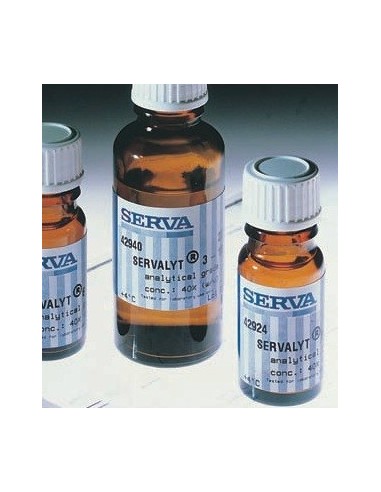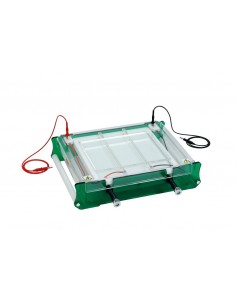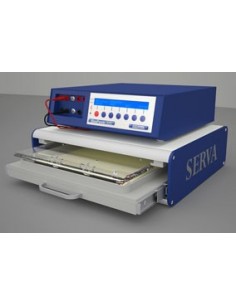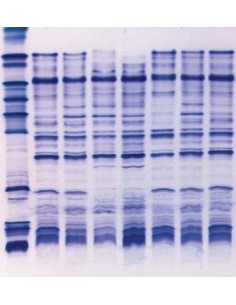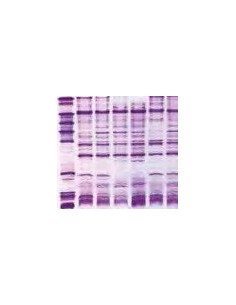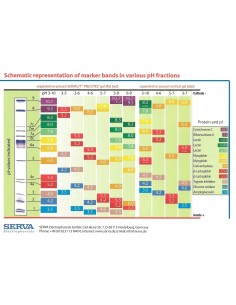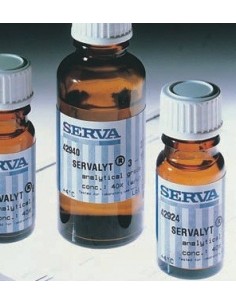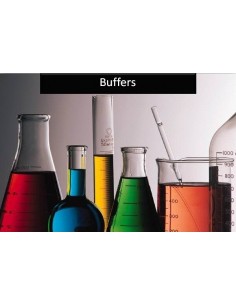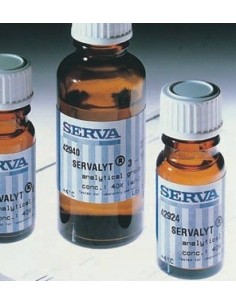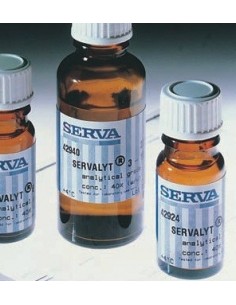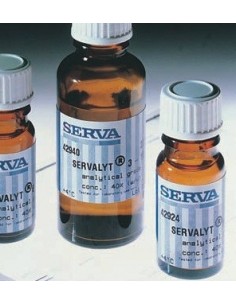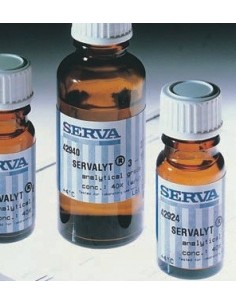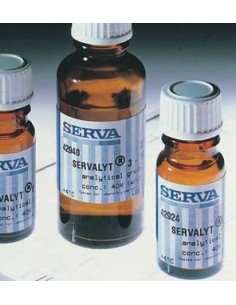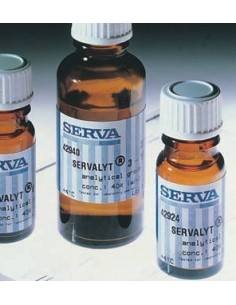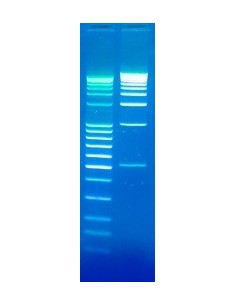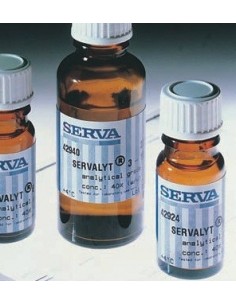Ampholytes 2-4 (Servalyt 2-4)
Carrier ampholytes 2-4 by Serva
Servalyts 2-4 carrier ampholytes can be used in cIEF and gel IEF to identify acidic isotypes in highly purified protein samples such as monoclonal antibodies or other biosimilar products. This narrow range allows you to zoom in on the pH gradient across the entire gel. Ampholytes are supplied as a 40% sterile solution (0.2um filtered). They have a 3 year shelf life when stored at 4oC unopened. Common working concentrations range from 3% to 5%.
Benefits:
- Available in two sizes: 10ml and 25ml
- High resolution
- Fast staining and clear background
- Ready to use and blendable
For comparative performance analysis see this article
Using an ampholyte pH 2-4 in isoelectric focusing (IEF) offers several benefits, including:
Specific separation of low pI proteins: The narrow pH range of 2-4 is well-suited for the separation of proteins with low isoelectric points (pI). It allows for a focused and precise separation of acidic proteins that have pI values within this range. This is particularly beneficial when analyzing samples enriched in acidic proteins or when targeting specific low pI proteins of interest.
High resolution for acidic proteins: The narrow pH range ensures a higher resolution for proteins with low pI values. The pH gradient established by the ampholytes enables these acidic proteins to migrate and focus precisely at their respective pI positions, resulting in sharp and well-resolved bands. This facilitates accurate identification and characterization of acidic proteins.
Minimization of interference: By using an ampholyte pH 2-4, the focusing range is limited to the acidic region, minimizing potential interference from proteins with higher pI values. This can be advantageous when dealing with complex samples containing a mixture of proteins with varying pI values, as it allows for selective separation and analysis of the acidic fraction.
Increased sensitivity for low pI proteins: The focused separation of low pI proteins achieved with an ampholyte pH 2-4 can enhance the sensitivity of detection methods. When analyzing low abundance acidic proteins, the reduced complexity of the pH range can lead to improved detection limits and a higher signal-to-noise ratio.
Simplified experimental setup: The use of a narrow pH range such as 2-4 simplifies the experimental setup for IEF. The preparation of the ampholyte mixture and the establishment of the pH gradient become more straightforward and manageable. This can save time and reduce potential sources of experimental variability.
Versatility with complementary techniques: IEF with an ampholyte pH 2-4 can be easily combined with other separation techniques. For example, after the acidic proteins have been separated using IEF, they can be further characterized or purified using additional techniques like gel electrophoresis, chromatography, or mass spectrometry. This integration of techniques allows for a comprehensive analysis of low pI proteins.
Research applications: The use of an ampholyte pH 2-4 in IEF finds particular relevance in research areas where low pI proteins play a crucial role, such as studying acidic enzymes, peptides, or specific protein isoforms. It provides a specialized tool for investigating these acidic components in complex biological samples.
In summary, using an ampholyte pH 2-4 in IEF offers specific separation and high resolution for low pI proteins, minimizes interference from other proteins, increases sensitivity, simplifies experimental setup, allows for versatility with complementary techniques, and finds application in research areas focused on acidic proteins.
"Serva ampholytes for High-Resolution Protein Focusing": Serva’s ampholytes offer researchers a reliable solution for achieving high-resolution protein focusing in IEF gels. With their broad pH range, enhanced resolution, and consistent performance, Serva ampholytes empower scientists to explore the intricate world of proteins with confidence.
Title: Amplifying Isoelectric Focusing with Serva Electrophoresis Ampholytes (Servalyts)
Introduction: Ampholytes play a crucial role in the field of isoelectric focusing (IEF), a powerful technique used for separating proteins based on their isoelectric points (pI). Serva Electrophoresis is a renowned leader in life science research tools and offers a range of high-quality ampholytes designed to enhance the accuracy and resolution of protein isoelectric-focusing experiments. In this article, we explore the significance of ampholytes and highlight the key benefits of Serva Electrophoresis ampholyte products.
Understanding Ampholytes and Isoelectric Focusing: Ampholytes are complex mixtures of amphoteric components with sulfonate and carboxylic groups on one end and free primary and secondary amino groups on the other. The degree of substitution and chain length will create mixtures with different pI value ranges. They act as buffering agents creating a stable pH gradient in the gel during IEF. These gels may be agarose gels or polyacrylamide gels. This pH gradient serves as the basis for separating proteins based on their pI, allowing researchers to achieve high-resolution protein analysis.
Key Benefits of Serva Electrophoresis Ampholytes (Servalyts):
1. Enhanced Resolution: Serva Electrophoresis ampholytes are formulated to generate highly reproducible pH gradients, ensuring accurate and precise separation of proteins. This leads to improved resolution and sharper banding patterns, enabling researchers to detect even subtle protein variations.
2. Broad pH Range: Serva Electrophoresis offers a deep selection of ampholytes with broad and single-point pH ranges, allowing researchers to target specific protein ranges based on their pI values. This flexibility enables the separation of a wide variety of proteins, from acidic to basic, expanding the scope of protein analysis.
3. Consistency and Reproducibility: Serva’s rigorous manufacturing processes ensure the production of consistent and reproducible ampholyte products. This reliability reduces experimental variability, enabling researchers to confidently replicate their results and compare data across experiments.
4. Easy-to-Use Protocols: Serva Electrophoresis provides comprehensive protocols and guidelines for using their ampholytes effectively. These protocols are designed to simplify the experimental workflow, allowing researchers to focus on their scientific objectives rather than technical challenges.
Conclusion: Serva Ampholytes are indispensable components in isoelectric focusing, facilitating the separation and analysis of proteins based on their isoelectric points. Serva Electrophoresis with its expertise and commitment to excellence offers a range of ampholytes that empower researchers to achieve superior results in protein-focusing experiments. By leveraging Serva’s high-quality ampholytes, scientists can unlock new insights into the complex world of proteins and drive advancements in various fields, including biotechnology, medicine, and biochemistry.
No reviews

